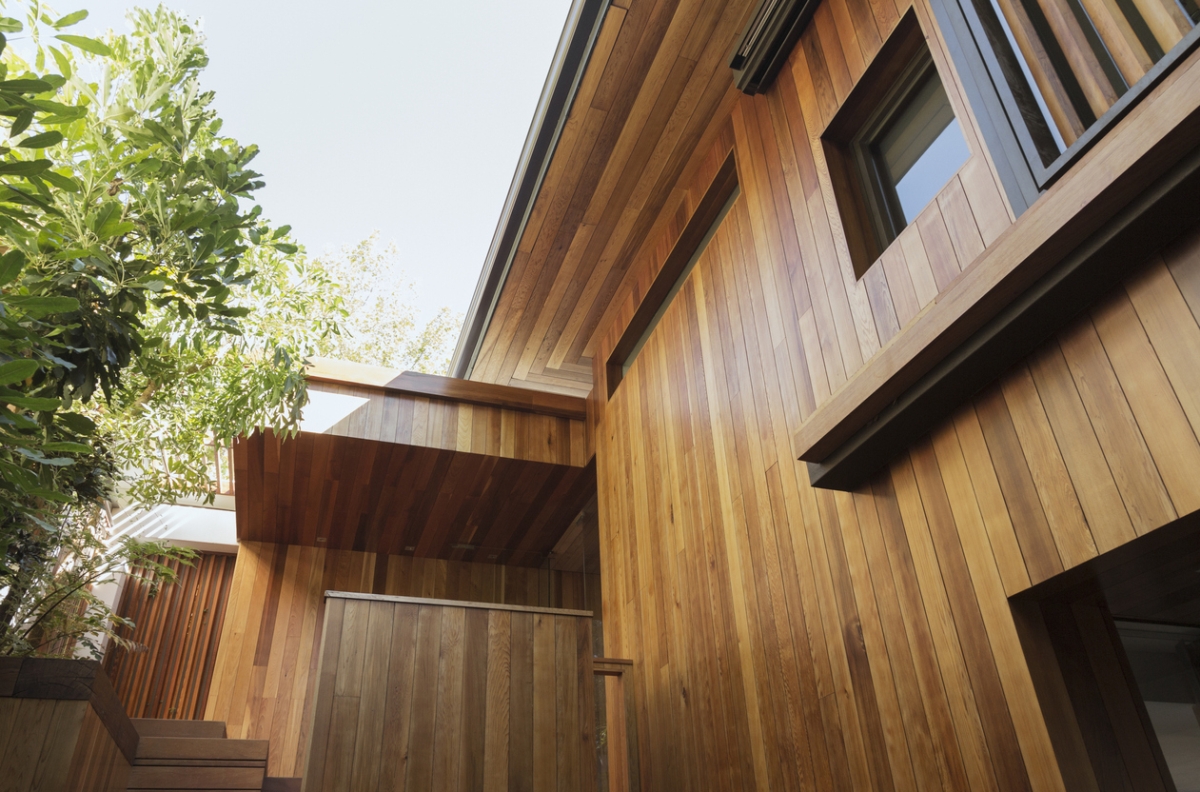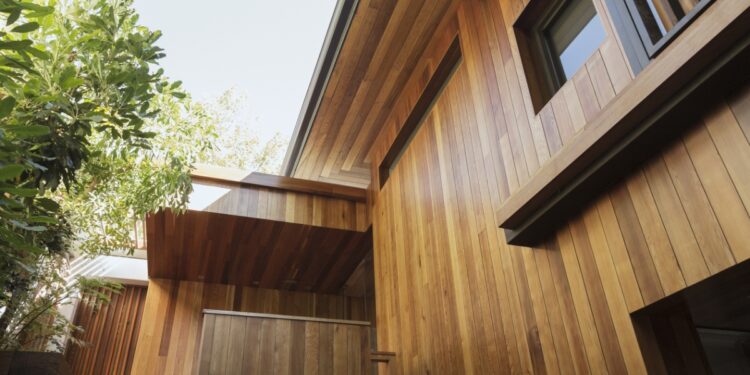Step into the world of natural wood siding houses where elegance meets sustainability. Discover the charm and warmth that natural wood brings to home exteriors, creating a timeless appeal that stands out in modern architecture.

Explore the various aspects of using natural wood siding to transform houses into inviting sanctuaries that blend seamlessly with nature.
Overview of Natural Wood Siding Houses
Natural wood siding is a popular choice for homeowners looking to add a rustic and timeless look to their houses. It is created from various types of wood that are cut into thin pieces and installed on the exterior walls of a home.
Characteristics of Natural Wood Siding
- Natural beauty: Wood siding adds warmth and character to a house, enhancing its overall aesthetic appeal.
- Durability: When properly maintained, natural wood siding can last for decades, standing up to harsh weather conditions.
- Versatility: Wood siding comes in various styles, finishes, and colors, allowing homeowners to customize the look of their homes.
Benefits of Using Natural Wood Siding
- Environmental sustainability: Wood is a renewable resource, making it an eco-friendly choice for siding material.
- Insulation: Wood siding provides natural insulation, helping to regulate the temperature inside the house and reduce energy costs.
- Increased home value: Homes with natural wood siding often have higher resale values due to their attractive appearance and durability.
Types of Natural Wood Commonly Used for Siding
- Cedar: Known for its natural resistance to decay and insects, cedar is a popular choice for wood siding.
- Pine: Pine siding is affordable and easy to work with, making it a budget-friendly option for homeowners.
- Redwood: Redwood siding is prized for its rich color and natural durability, making it a premium choice for those looking for high-end siding material.
Design and Aesthetics
Natural wood siding on houses offers a timeless and elegant aesthetic that can enhance the overall look of a home. The warm, organic feel of wood creates a welcoming atmosphere and adds character to the exterior of a house.Natural wood siding complements various architectural styles, including traditional, rustic, modern farmhouse, and even contemporary designs.
The versatility of wood allows it to seamlessly blend with different styles, adding a touch of natural beauty to any home.One of the key benefits of natural wood siding is its ability to enhance curb appeal. The rich texture and natural tones of wood can make a house stand out in a neighborhood, creating a visually appealing facade that catches the eye of passersby.
Whether stained or left to weather naturally, wood siding adds depth and dimension to a home's exterior, making it a popular choice among homeowners looking to boost their home's curb appeal.
Examples of Architectural Styles
- Traditional: Natural wood siding can complement the classic lines and timeless appeal of traditional architecture, adding charm and character to the exterior of a house.
- Rustic: Wood siding fits perfectly with rustic styles, enhancing the cozy and inviting look of a cabin or cottage-inspired home.
- Modern Farmhouse: The combination of wood siding with modern elements creates a fresh take on farmhouse style, blending the warmth of wood with contemporary design.
- Contemporary: In contemporary architecture, natural wood siding can add a touch of warmth and texture, creating a striking contrast with sleek lines and minimalist features.
Installation and Maintenance
Installing natural wood siding on a house requires careful attention to detail to ensure longevity and proper functionality
. The process involves several key steps, including preparation of the surface, cutting and fitting the wood pieces, and securing them in place.
Installation Process
- Prepare the surface by removing old siding and repairing any damage to the underlying structure.
- Measure and cut the wood siding to fit the dimensions of the house, taking care to leave room for expansion and contraction.
- Apply a weather-resistant barrier, such as house wrap, to protect the wood from moisture and other elements.
- Secure the siding in place using nails or screws, making sure to follow manufacturer guidelines for spacing and fastening.
- Finish the installation by sealing joints and applying a protective finish to enhance durability and resist weathering.
Maintenance Requirements
- Regularly inspect the siding for signs of damage, such as rot, warping, or insect infestations, and address any issues promptly.
- Clean the siding periodically to remove dirt, mold, and mildew, using a mild detergent and soft brush to avoid damaging the wood.
- Reapply protective finishes as needed to maintain the wood's natural beauty and prolong its lifespan.
- Monitor the caulking and sealant around windows, doors, and other openings to prevent water infiltration and damage to the siding.
Cost Comparison
- Natural wood siding tends to have a higher initial cost compared to other materials like vinyl or fiber cement.
- However, the long-term maintenance costs of wood siding can be lower, as it can be repaired and refinished rather than replaced entirely.
- Overall, the cost of installing and maintaining natural wood siding may vary depending on factors such as the type of wood, the size of the house, and local labor rates.
Environmental Impact
When it comes to the environmental impact, natural wood siding is considered a sustainable and eco-friendly option for exterior cladding.
Eco-Friendliness of Natural Wood Siding
Natural wood siding is a renewable resource that can be harvested responsibly from forests managed with sustainability in mind. This means that trees are replanted to ensure a continuous supply of wood for construction purposes.
- Wood siding has a lower carbon footprint compared to synthetic materials like vinyl or aluminum.
- Wood siding is biodegradable and can be recycled or repurposed at the end of its lifespan, reducing waste.
- Wood siding acts as a natural insulator, reducing the energy needed for heating and cooling a home.
Comparing Sustainability with Other Siding Materials
When compared to other siding materials, natural wood siding stands out in terms of sustainability and environmental impact.
| Siding Material |
Sustainability |
| Natural Wood |
Renewable, biodegradable, lower carbon footprint |
| Vinyl |
Not biodegradable, releases toxins during manufacturing |
| Aluminum |
Energy-intensive production, not biodegradable |
Contribution to Green Building Design
Utilizing natural wood siding in construction projects can contribute significantly to green building design practices.
- Wood siding promotes a natural aesthetic that blends harmoniously with the surrounding environment.
- Wood siding can be sourced locally, reducing transportation emissions.
- By choosing FSC-certified wood, which comes from sustainably managed forests, builders can further enhance the green credentials of a project.
Final Summary
As we conclude our journey through the realm of natural wood siding houses, it becomes evident that these timeless structures not only enhance the aesthetic appeal of homes but also contribute to a greener environment. Embrace the beauty and eco-friendliness of natural wood siding to create a harmonious living space that reflects your values and style.
Essential Questionnaire
What are the main benefits of natural wood siding?
Natural wood siding offers excellent insulation, durability, and a visually appealing finish that enhances the overall look of a house.
How do you maintain natural wood siding?
Regular cleaning, staining, and sealing are essential for maintaining the beauty and longevity of natural wood siding.
Is natural wood siding environmentally friendly?
Yes, natural wood siding is a sustainable choice as it is biodegradable and renewable, making it an eco-friendly option for home exteriors.
 Explore the various aspects of using natural wood siding to transform houses into inviting sanctuaries that blend seamlessly with nature.
. The process involves several key steps, including preparation of the surface, cutting and fitting the wood pieces, and securing them in place.
Explore the various aspects of using natural wood siding to transform houses into inviting sanctuaries that blend seamlessly with nature.
. The process involves several key steps, including preparation of the surface, cutting and fitting the wood pieces, and securing them in place.
 Explore the various aspects of using natural wood siding to transform houses into inviting sanctuaries that blend seamlessly with nature.
Explore the various aspects of using natural wood siding to transform houses into inviting sanctuaries that blend seamlessly with nature.




![How to Cancel CarShield [Explained]](https://health.radartasik.id/wp-content/uploads/2025/11/Carshield-Vs-Endurance-120x86.png)

